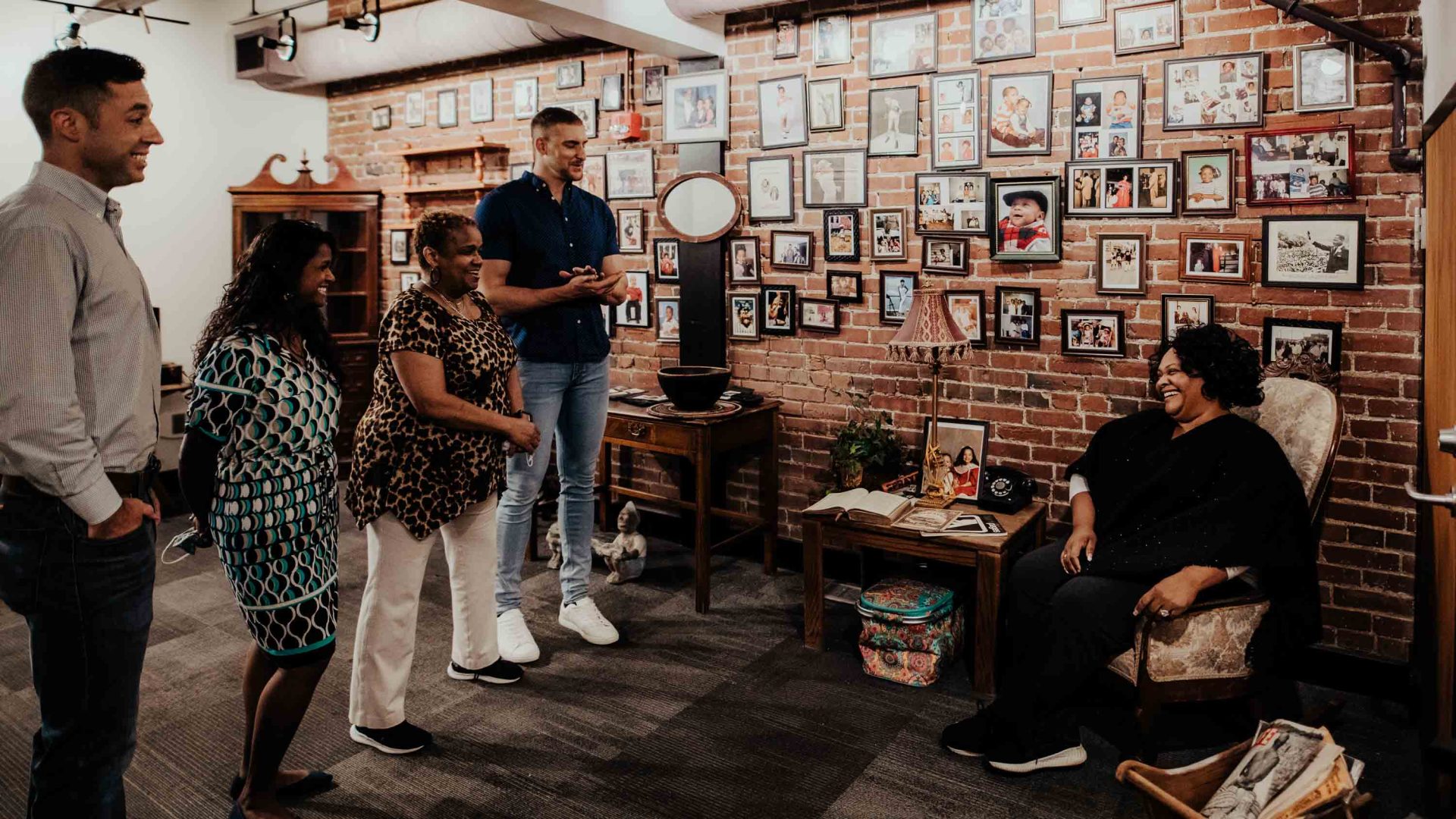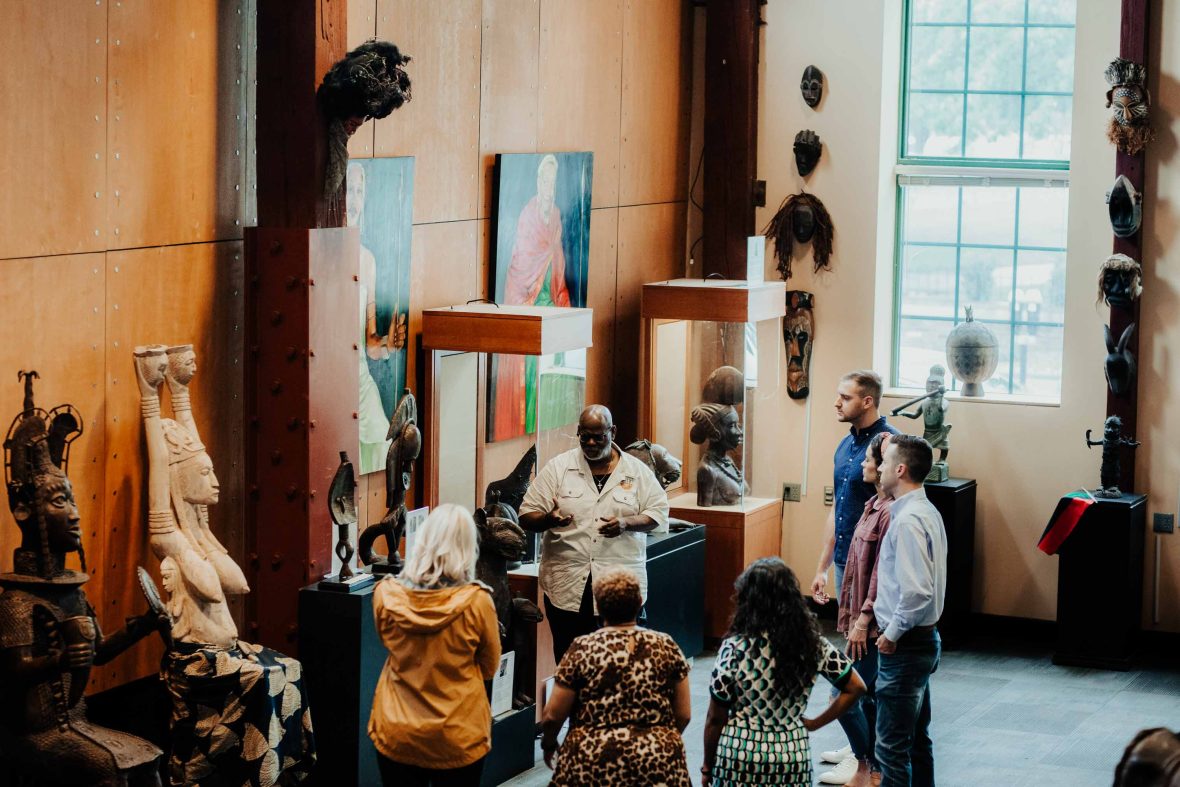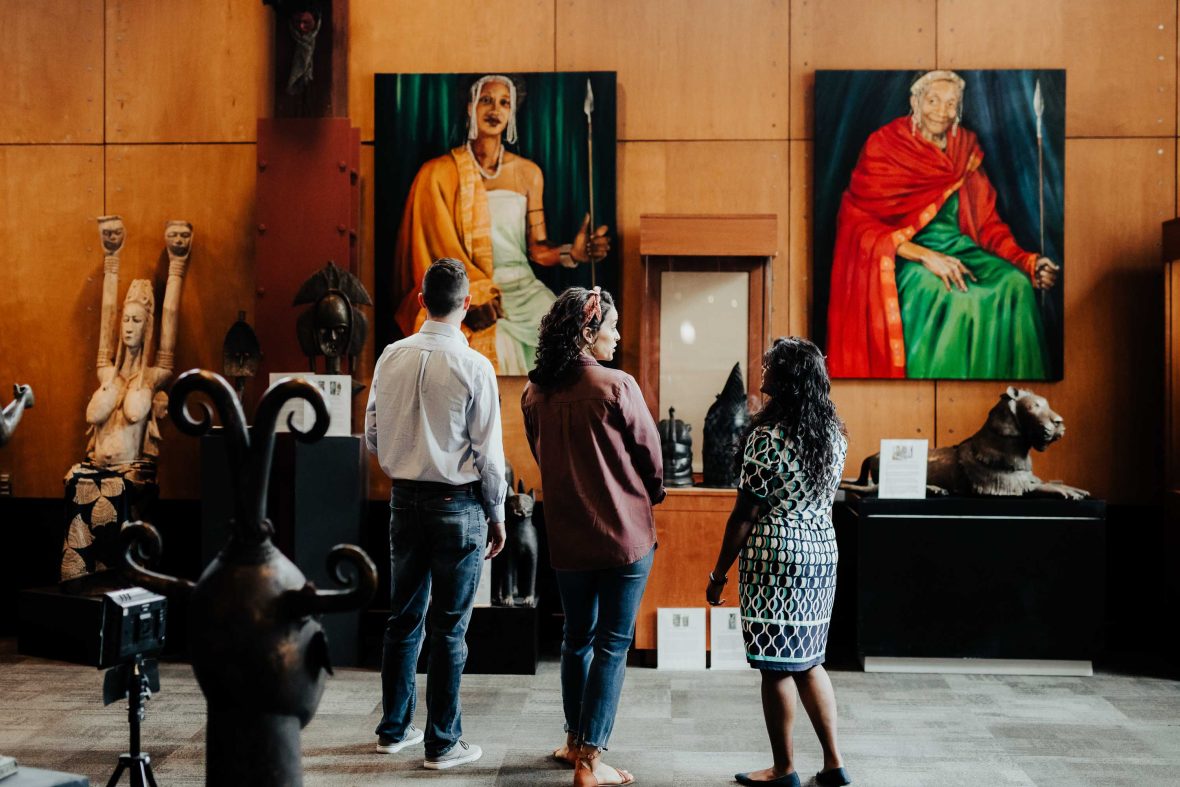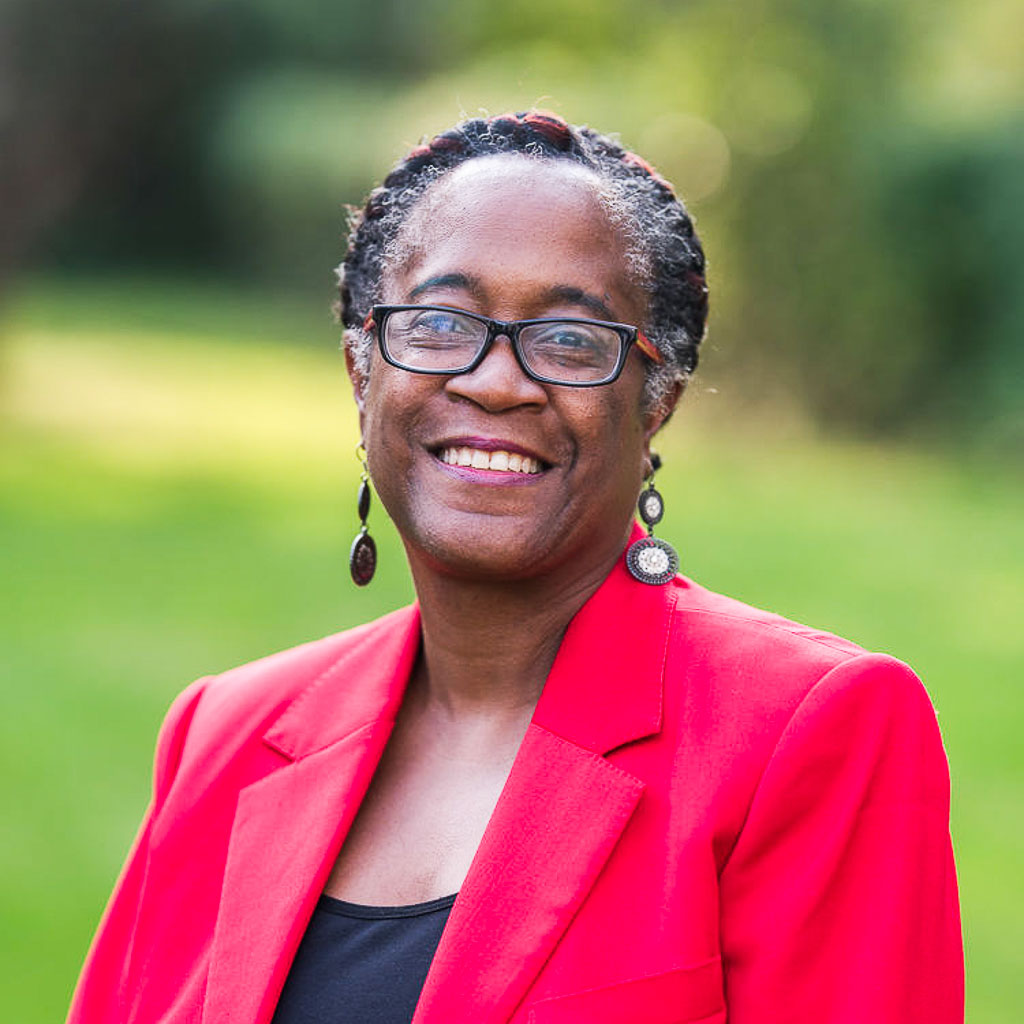
Driven by a desire to educate locals and travelers on Black history, Lamont Collins opened a museum—and stocked it with his own personal artefacts. Rashmi Narayan heads to Kentucky for a visit.


Driven by a desire to educate locals and travelers on Black history, Lamont Collins opened a museum—and stocked it with his own personal artefacts. Rashmi Narayan heads to Kentucky for a visit.
I quickly realize this is no ordinary museum. As I walk around the main space looking at the Faces of Africa exhibit, I notice a brass sculpture with African people in chains. The museum’s founder Lamont Collins tells his assistant to ‘bring out the chains.’ A set of heavy iron chains are presented and Collins asks me to step forward and put my hands in front of me. I’m perplexed: I assume he’d let me hold the chains (which came directly from a family estate in Ghana) to assess how heavy they were.
Instead, he places the chains on my wrists and says, “Welcome to America!” I’m shocked and silent for a few seconds. He then removes the chains and asked, “How did that feel? What are your thoughts?”
“Horrifying,” I reply.
“This is exactly how the Black people who were brought to America as enslaved people felt.” Collins is aware that items and moments like this are shocking and upsetting, but that seems to be precisely the point.
Tucked away from a busy main street in downtown Louisville, this is the Roots 101 African American Museum. On first glance, it might appear to be a spacious gallery with various collections, but there are exhibits from Benin, Ghana, posters of Black artists and a pair of weighty chains on the walls.
It’s the story of the USA, seen through the lens of one man’s African American experience.

Roots 101 is the brainchild of Lamont Collins. Collins grew up in largely white Louisville in the 1960s, but managed to thrive mainly due to his athletic abilities. Many of his sports idols were Black, but their struggles were barely known—from an early age, Collins realized how integral it was to tell African American stories.
For decades, Collins has been a collector of artifacts, from West Africa to Louisville. An autograph by the young Muhammad Ali (who was still Cassius Clay then) was the first piece that started his collection.
Collins opened the museum in 2021 and since then, it has ranked consistently high in the list of attractions in Kentucky. Named after the first class taken on any subject in higher education—a 101—it aims to offer an immersive introduction to better understand African-American history.
“Martin Luther King said in the 1960s that we need to stand straight, because if you don’t, they ride your back like a horse. So, I say no matter what we went through, we went through it standing up straight, with character and humanity.”
- Lamont Collins
Though Collins understands that it’s the exhibits that make this museum unique, he says, “My aim and emphasis is on the Black experience. You can touch and feel everything throughout this museum because I believe that visitors need to feel and touch the story.”
We casually strike up a conversation on all things Kentucky—from bourbon to bluegrass to the annual Derby. Collins tells me Black horsemen played a key role in shaping early American turf history, especially in the Kentucky Derby, and he points out that many of the winners in Churchill Downs during the 19th century were Black.
“They were known as horse whisperers,” says Collins. “In West Africa, they had horses long before the United States of America. Because they grew up with horses, they had a strong relationship with them. What I’m trying to show here is that Black people were connected to Africa in more ways than they knew—because it is who we are and what we are.”

From 1619 to 1865, millions of Africans were sold into slavery as part of the Transatlantic Slave Trade. The main slave trading ports were South Carolina, Philadelphia, Georgia and Virginia—the majority of enslaved people in Kentucky were in Louisville and Lexington.
There are advertisements in the ‘Welcome to America’ room, where I immediately spot a poster dating back to the 1760s which reads: “A cargo of ninety-four prime, healthy negroes just arrived in the Brigantine from Sierra Leone.” Right next to a pair of rusty ankle chains, an auction sign read: “On Monday the 18th of May 1829, for sale the following slaves and also for sale fine rice, gram, paddy, books, needles, pins, ribbons etc.”
Collins says his most powerful piece in the main space is that of a fragile, standing enslaved man whose hands are chained behind him.
“I tell young people that even though this man is chained, he’s standing upright,” he tells me. “Martin Luther King said in the 1960s that we need to stand straight because if you don’t, they ride your back like a horse. So, I say no matter what we went through, we went through it standing up straight, with character and humanity.”
Within months of opening its doors to the public, Roots 101 was recommended as one of the Best New Attractions by USA Today—folk singer James Taylor praised the museum during his performance in Louisville and many locals speak of the profound effect the museum has had on them. When asked about the challenges faced so far, Collins says, “The only setback has been the lack of local government and corporate support in supporting a museum that has become nationally recognized. I always say they call Roots 101 a treasure but not many have put treasure in our chest.”
During our conversation on how history is taught in the USA, Collins mentions the Liberty Bell in Philadelphia, widely seen as an emblem of freedom. The historic bell dates back to 1752 and its inscription is from the Bible (King James version): Proclaim Liberty Throughout All the Land Unto All the Inhabitants thereof.
This inscription inspired abolitionists to rally against slavery. “In school, we always learnt that the Liberty Bell was a symbol of freedom in America,” says Collins. “Well, it wasn’t a symbol of freedom for Black people. It’s not about the crack in the bell as our schools focused on—it’s the crack in the foundation of America. Black people were never considered in the foundation of America.”
You need strength inside the museum’s Circle of Hate room. Among many exhibits, such as mannequins dressed like the Ku Klux Klan that are holding a noose, there are also many ‘campaign posters’. One of the handwritten leaflets here read, ‘You’ve got to pitch in to clean up America’s communist, traitor, race-mixer pollution, otherwise it won’t be America anymore.’ There are also many rusty old signs that state ‘Colored Entrance Only’ depicting the country’s past on its racial segregation.
“America was OK with Black people as long as they were entertaining.”
- Lamont Collins
With a heavy, uneasy feeling and barely able to contain my tears, I walk on to explore the rest of the museum that tells stories through struggle and progress. It took “Big Momma’s House” to lift my spirits. Recreated in the style of a Black grandmother’s living room with a small television, family photos on the wall and a piano, it’s a throwback to family spaces of the 1960s and a reminder that Black people in the US had forged communities, family life and domestic life despite their beginnings in this land.
For Collins, this gallery is particularly special. “Our stories were never told through our history books, it was told through our grandmothers,” he says. “How we learned who we truly were was through her. She put pictures on the walls of Black people that had been successful. We wouldn’t know otherwise.”
Outside Big Momma’s House is “The Great Equalizer” wall featuring numerous photos of sporting greats, from Muhammad Ali to NBA’s Darrell Griffith, a reminder of what has been achieved by Black people in the US despite their brutal history.
Above this is the ‘Protest to Progress’ gallery. The idea behind this is for the next generation to see themselves making history, to take action and make their lives better than their ancestors. In the Roots of Music space, my eye is immediately drawn to a poster of one of my favorite artists, Earth, Wind & Fire, and I smile. The song ‘Boogie Wonderland’ is consistently ranked high on my Spotify playlist and gave me a little dopamine boost.
In an exhibit dubbed ‘Black To The Future’, Collins describes it as unapologetically Black. “It is for any Black kid to come in and know that there is a future for him or her in this country and that one doesn’t have to be dead to be famous.”
The walls are lined with photographs provided by locals of their children dressed in the profession they see their future in. There were photos of children dressed as lawyers, doctors, chefs, footballers, musicians and ballerinas.

Before leaving the museum, Collins turns to me. “America was OK with Black people as long as they were entertaining,” he says. “Think about this: We see entertainers and sports stars who are Black, but have you ever wondered how many of them actually have any ownership? How many Black people today own sports teams? How many of them own distilleries in Kentucky?
“Look at our own Muhammad Ali who was from Louisville and the challenges he faced to soar to new heights. I tell kids nowadays; it’s not about wearing a brand—it’s about owning it.”
Collins believes that Black people cannot achieve equality in race when it comes to wealth and assets and still have a long way to go. For Collins, his museum—which presents an unflinching, honest, painful and celebratory portrayal of the African American experience—is a good place to start thinking about it.
***
Adventure.com strives to be a low-emissions publication, and we are working to reduce our carbon emissions where possible. Emissions generated by the movements of our staff and contributors are carbon offset through our parent company, Intrepid. You can visit our sustainability page and read our Contributor Impact Guidelines for more information. While we take our commitment to people and planet seriously, we acknowledge that we still have plenty of work to do, and we welcome all feedback and suggestions from our readers. You can contact us anytime at hello@adventure.com. Please allow up to one week for a response.

Rashmi Narayan is a travel, food and drink journalist who often uses her curiosity to explore the world through food and drink. She writes for a wide range of publications and websites, and has a passion for sustainability, stargazing, train journeys and history. She lives in London with an ever-growing collection of non-fiction books, steam train models and vinyl records.








Can't find what you're looking for? Try using these tags: